- Главная
- Разное
- Бизнес и предпринимательство
- Образование
- Развлечения
- Государство
- Спорт
- Графика
- Культурология
- Еда и кулинария
- Лингвистика
- Религиоведение
- Черчение
- Физкультура
- ИЗО
- Психология
- Социология
- Английский язык
- Астрономия
- Алгебра
- Биология
- География
- Геометрия
- Детские презентации
- Информатика
- История
- Литература
- Маркетинг
- Математика
- Медицина
- Менеджмент
- Музыка
- МХК
- Немецкий язык
- ОБЖ
- Обществознание
- Окружающий мир
- Педагогика
- Русский язык
- Технология
- Физика
- Философия
- Химия
- Шаблоны, картинки для презентаций
- Экология
- Экономика
- Юриспруденция
Что такое findslide.org?
FindSlide.org - это сайт презентаций, докладов, шаблонов в формате PowerPoint.
Обратная связь
Email: Нажмите что бы посмотреть
Презентация на тему The Tower of London
Содержание
- 2. The Tower of London is the most
- 3. Castle building was an essential part of
- 4. After his coronation in Westminster Abbey on
- 5. Initially the Tower had consisted of a
- 6. It was built by Norman masons and
- 7. The Tower c. 1100 The Tower c.
- 9. The White Tower is the most ancient
- 10. The White Tower was protected to the
- 11. The Cradle Tower built by Edward III
- 12. During the reign of
- 13. It is important for us today to
- 14. The Tower c.1547.
- 16. The Queen's House was where distinguished prisoners
- 17. The Tower is guarded by a military
- 18. The Tower never had to face an
- 19. From Queen To Prisoner Lady Jane GreyOn
- 21. The monarchy was restored in 1660 and
- 22. From Fortress to Ancient Monument Between 1800
- 23. However, before these changes took place the
- 24. The Lion Tower. To
- 26. Only the ravens of the Tower remind
- 30. The Tower of London is the most
- 31. The Armour Room. Today you can see
- 32. Скачать презентацию
- 33. Похожие презентации
The Tower of London is the most famous of all the historical buildings in London. It stands today almost unchanged since it was built in the 11th century. In the past the Tower of London served


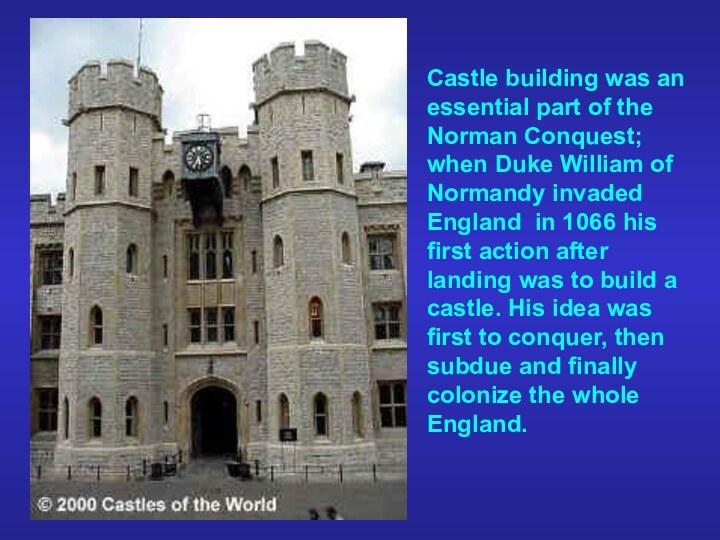
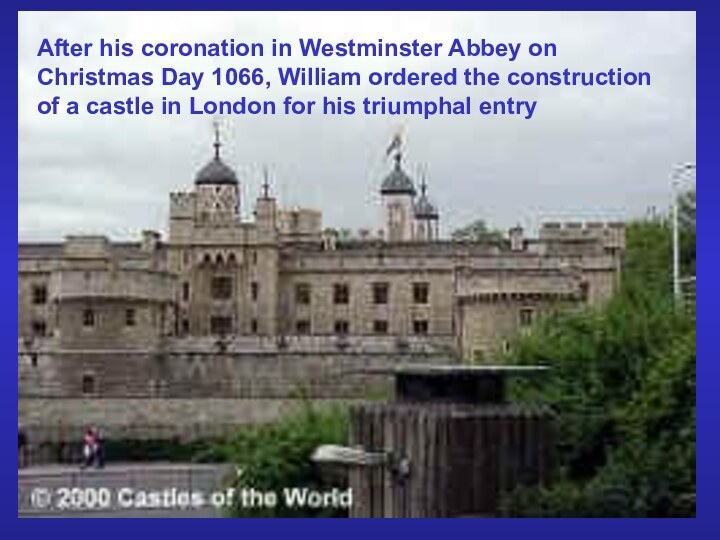







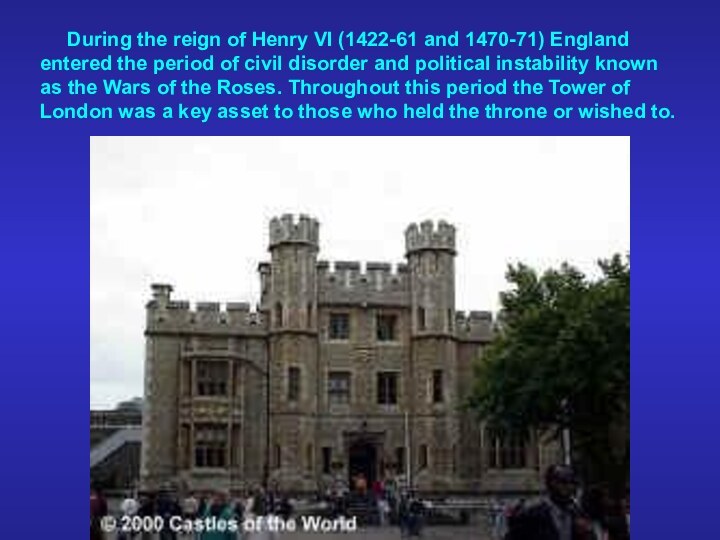
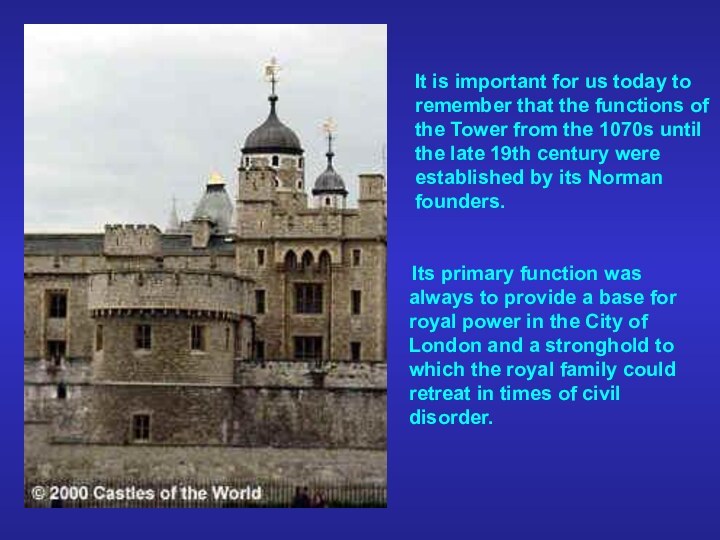






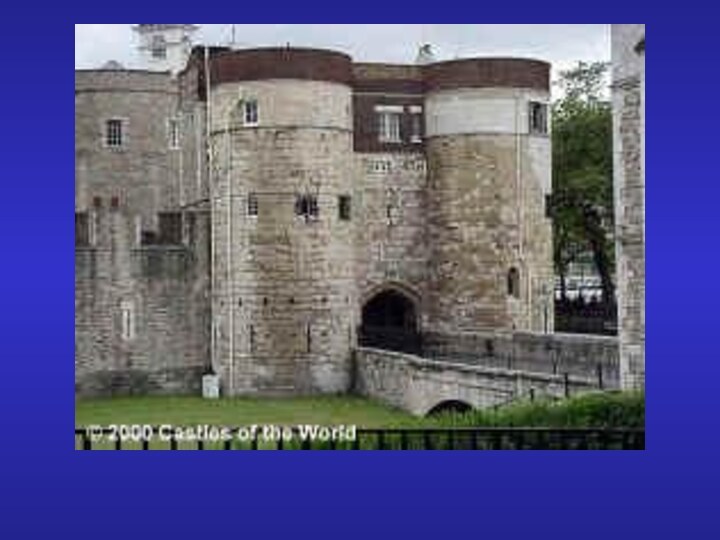




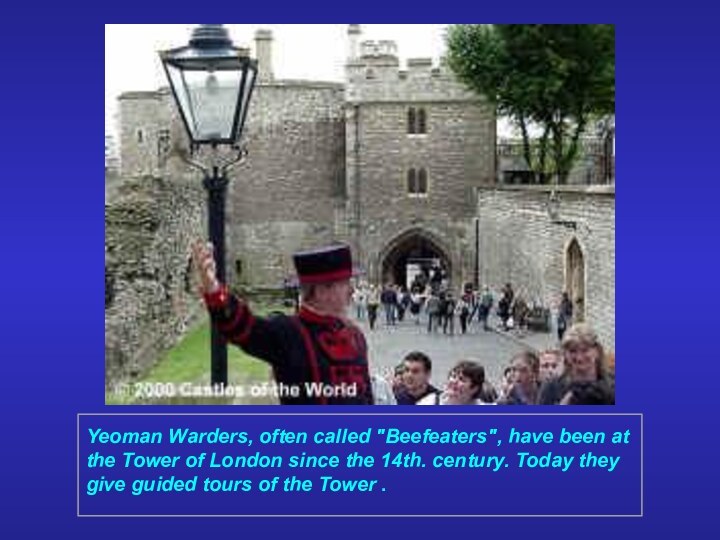
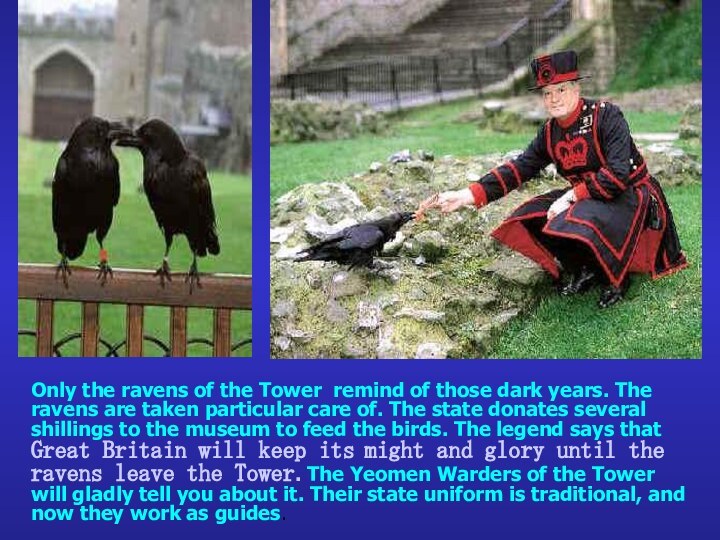






Слайд 3
Castle building was an essential part of the
Norman Conquest; when Duke William of Normandy invaded England
in 1066 his first action after landing was to build a castle. His idea was first to conquer, then subdue and finally colonize the whole England.Слайд 4 After his coronation in Westminster Abbey on Christmas
Day 1066, William ordered the construction of a castle
in London for his triumphal entryСлайд 5 Initially the Tower had consisted of a modest
enclosure built into the south-east corner of the Roman
City walls, but by the late 1070s, with the initial completion of the White Tower, it had become the most fearsome of all. Nothing had been seen like it in England before.Слайд 6 It was built by Norman masons and English
(Anglo-Saxon) labor drafted in from the countryside. It was
intended to protect the river route from Danish attack, but also and more importantly to dominate the City physically and visually.
Слайд 9 The White Tower is the most ancient part
of the Tower and the oldest building of London.
But if you try to find a tower in the Tower, and moreover, a white one, you will certainly fail to do it. This dark with age building with four small towers in the corners is the White Tower. Its walls, once white washed, are almost 4 meters thick. Now the White Tower is a museum.Слайд 10 The White Tower was protected to the east
and south by the old Roman City walls (a
full height fragment can be seen just by Tower Hill underground station), while the north and west sides were protected by ditches as much as 750m (25ft) wide and 3.40m (lift) deep and an earthwork with a wooden wall on top.Слайд 12 During the reign of Henry
VI (1422-61 and 1470-71) England entered the period of
civil disorder and political instability known as the Wars of the Roses. Throughout this period the Tower of London was a key asset to those who held the throne or wished to.Слайд 13 It is important for us today to remember
that the functions of the Tower from the 1070s
until the late 19th century were established by its Norman founders. Its primary function was always to provide a base for royal power in the City of London and a stronghold to which the royal family could retreat in times of civil disorder.
Слайд 14
The Tower c.1547.
The Tower in Tudor Times: A Royal Prison The first Tudor monarch, Henry VII (1485-1509) was responsible for building the last permanent royal residential buildings at the Tower. He extended his own lodgings around the Lanthorn Tower adding a new private chamber, a library, a long gallery, and also laid out a garden.
Слайд 16 The Queen's House was where distinguished prisoners were
held, including Henry VIII's second wife, Anne Boleyn. The
last prisoner to stay in the Queen's House was Rudolf Hess, the Deputy Fuhrer of Nazi Germ
Слайд 17
The Tower is guarded by a military guard.
;
Queen Elizabeth 1 (1558-1603) spent much of her reign
warding off the threat from Catholic Europe, and important recusants (people who refused to attend Church of England services) and others who might have opposed her rule were locked tip in the Tower. Never had it been so full of prisoners, or such illustrious ones: bishops, archbishops, knights, barons, earls and dukes all spent months and some of them years languishing in the towers of the tower of London.Слайд 18 The Tower never had to face an assault.
Its fortresses became a state prison for the greatest
political leaders of the country.Most prisoners were criminals only in the eyes of the government. Sir Thomas More, one of the greatest scientists of the Renaissance, lost his head here. Lady Jane Grey who was the Queen of England for several days was also kept here





























